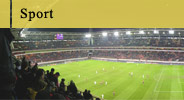Cork City’s Colin Healy talks to ROBERT CARRY about the leg breaks that threatened his career, those comparisons to Roy Keane, and his ambition to go as far as he can in his football career
“Nothing is surprising in professional football,” says Colin Healy, the gifted Cork-born midfielder whose time in the professional game has seen more twists and turns than your average team would see in a decade.
The 27-year-old’s playing days began in his native Ballincollig in Cork, where despite trying his hand at a number of sports, there was only ever one path he wanted to follow. “I played Gaelic football and golf when I was growing up but it was always my ambition to be a professional footballer,” says Healy, who after a stint with local club Wilton United signed up to the FAI’s football course run through the national employment agency, FÁS.
It wasn’t long before scouts from abroad started to make regular sideline appearances during the tough tackler’s high-tempo performances. “Clubs from England and Scotland started to watch me constantly,” recalls Healy.
The Cork branch of the course was run by former Celtic midfielder and fellow Cork native Mick Conroy and the Glasgow giants stepped in to make the player an offer. “I was very excited,” says Healy, “Celtic are one of the greatest clubs in the world, so naturally it was a big thing for me.”
The player had a mixed time with Celtic, performing well when given the chance but not seeing as much first team action as he would have wished. But despite the difficulties, it was a period of his career Healy recalls fondly. “I enjoyed it, and I learned a lot there,” he notes. One big plus of playing for Celtic at the time was that mercurial Derryman Martin O’Neill was at the helm. Working under O’Neill, a manager known almost as much for his full-blooded pitch-side performances as he is for his remarkable managerial success, helped to drive his Celtic squad to a string of domestic victories and strong runs in European competition. “Martin is a very passionate man,” says Healy, “and he expects the same in return.”
In 2001, Healy was offered the chance of more regular first team football with Champion-ship side Coventry. “It was a defining moment if you like. You make a decision, and then you give it your best.” The decision proved key, and Healy’s career began to really take off. After a hugely successful three month spell at Coventry under former Liver-pool player Gary McAllister, Healy was recalled to Glasgow where he started to see more regular football. But the loan move did its job and then Republic of Ireland manager Mick McCarthy, an individual who would feature heavily in the player’s career, gave him a call-up to the national squad for a friendly against Russia.
Despite only being on the field for 45 minutes, Healy was hugely impressive on his senior international debut and was awarded man of the match for his role in the Irish engine room beside Ireland legend and fellow Corkman Roy Keane. “It was wonderful,” remembers Healy. “It was the realisation of a dream really.”
Healy’s performances were enough to earn him two more call-ups to an Ireland side preparing for the 2002 World Cup with a series of friendlies. Healy’s display against Russia was followed by two more strong international outings, against the US and Denmark, and the Irish press began hailing him as the successor to the crown of his international midfield partner. But Healy refused to be swayed by the somewhat lazy comparisons. “I’ve never thought about it much,” he admits. “I’m not Roy Keane.”
Healy’s performances look-ed to have made him a shoe-in for inclusion in the World Cup squad but McCarthy, known for being a doggedly loyal manager even towards under-performing players, opted to leave Healy at home in favour of the more experienced campaigners in contention. “I was obviously very disappointed,” he admits.
However, Healy’s plan to “watch the World Cup on TV with some mates back in Cork” seemed to have been snookered when the now legendary row between Keane and McCarthy erupted in the days before the tournament began. McCarthy quickly named Healy as the squad replacement, should Keane be dropped. Sadly, the Roy Keane will-he-won’t-he drama dragged on past the final Fifa squad list deadline and Healy missed his chance to play a part in the world’s biggest sporting competition. It is something he is obviously reluctant to talk about.
But even when the lights were flicked off in the stadiums around Japan and Korea at the close of World Cup 2002, the Keane-versus-McCarthy saga rumbled on – and the ripples would continue to affect Healy’s career. After a series of poor Ireland performances, McCarthy was booed out of his job by a crowd populated to a great degree by fans who blamed him for Keane’s exit. But McCarthy’s services were soon in demand and he was offered the manager’s post at Premiership strugglers Sunder-land in 2003. Bizarrely, the man who had chosen to leave Healy at home for the World Cup contacted Celtic Park in an attempt to lure the player to the Stadium of Light ahead of their first season back in the Championship.
Healy agreed to the move but controversy reared its head when Celtic sought compensation from Sunderland for losing the player, who signed on a free transfer. Fifa was forced to step in to the row and eventually ruled that because Healy was over 23 at the time, Celtic were not entitled to any form of payment from Healy’s new club. With the transfer wrangle behind him, Healy was finally free to concentrate on playing and he immediately began making his mark in the second tier of English football. However, tragedy struck – and in a manner which would make his previous disappointments pale in comparison.
In December 2003, just days after the Celtic dispute was finally settled, Healy lined out for Sunderland in a game against Coventry – the club where his loan spell had kick-started his international career. When the game was in full swing, Healy went down under a heavy challenge from Moroccan international star Youssef Safri. A loud crack was clearly audible when the pair collided. Paramedics rushed onto the field where they immediately applied an oxygen mask to the face of the stricken Irishman before carrying him from the stadium.
Healy’s leg was broken in two places and his career looked in danger of being cut short. The player spent the next nine months slowly rebuilding his limb while the world of football continued on around him. Sunderland kept faith with the player and fans eagerly awaited the return of the midfielder who had impressed during his handful of pre-injury outings.
Finally, in October 2004, Healy was ready to resume full training under his Sunderland and former Ireland manager Mick McCarthy. Healy was on the brink of making his comeback when former defender McCarthy, who was in the habit of training amongst his players, challenged the player in what Healy has described as a straightforward tackle. Foot-ball fans across Ireland and the UK recoiled when news broke that Healy had snapped the same limb again.
Healy suffered during his rehabilitation but the thought of quitting never occurred to him. “Injury is one of the most difficult aspects of professional football. Many, many months of lonely rehab teaches you a lot about yourself. I never contemplated packing it in, though.”
The healing process was aided by the fact that Healy was allowed to return to his native Cork where he could nurse himself back to health in familiar surroundings. The player points out: “Family and friends are the great constants in life.”
In January 2006, Healy’s Sunderland career ended and the midfielder opted for a return to Scotland. He played with SPL side Livingston until the end of the season before signing a one year contract with English club Barnsley. Healy got to line out against the club at which his career was nearly ended when Barnsley visited the Stadium of Light, and when Healy came on as a substitute, Sunderland fans in the 50,000-seater stadium gave him a standing ovation.
After 10 games for Barnsley, Healy returned to Ireland where he signed for home town club Cork City – but predictably, controversy not of his making somehow followed. Fifa ruled that players could not play for three clubs in one 12 month period which made him, and fellow Cork signing Gareth Farrelly, ineligible for four months.
“It was immensely frustrating,” Healy recalls. “Injury and red tape have combined to take three years from my career.”
On 1 July, a now eligible Healy took to the field for City’s under-21 game against Lifford. Days later he made his full return to first team football for Cork against Dublin rivals Bohemians. “I was like a youngster again,” Healy remembers. “I was nervous, yeah, but I was also thrilled. Nerves are an important part of a professional’s life anyway.”
Healy freely admits that although he is still hoping to go as far and as high as he can, he is very much enjoying his time with Cork.
“I still possess great ambition and strong confidence. It is my intention to make the most out of the remainder of my career. That said, Cork City is a great club. The fans are fantastic, and the spirit in the dressing room is terrific.”
Football tends to be inflexibly partisan, but even football fans who despise Celtic, loath Coventry and can’t stand Cork or Sunderland, will be hoping that Healy gets to enjoy many more years playing professional football – he’s certainly earned it.











